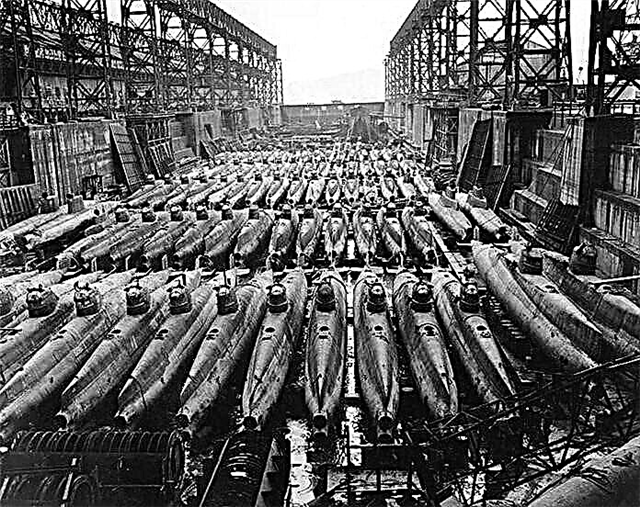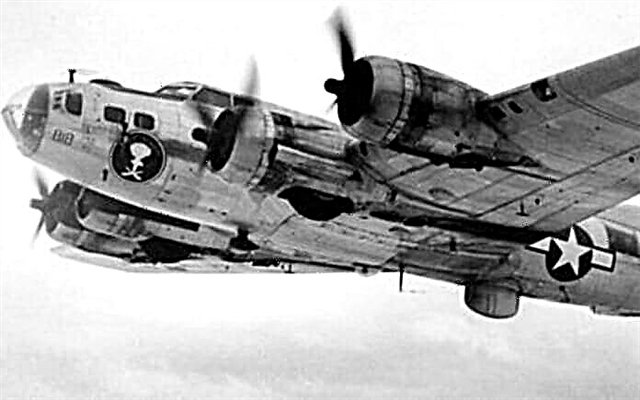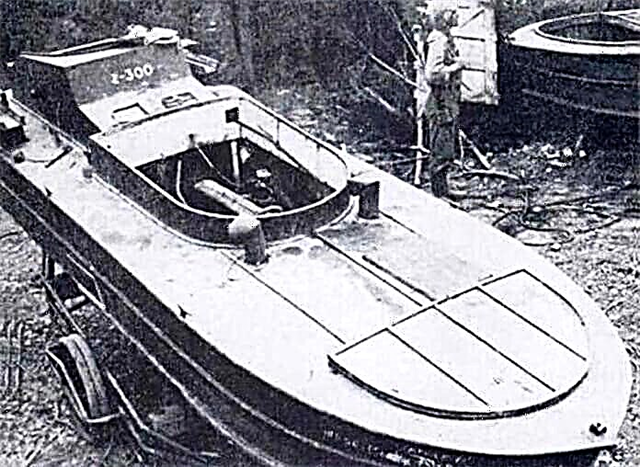In an effort to inflict as much damage as possible on the enemy, the military of different countries went to experiments that can now be called inhumane. As live weapons, animals, birds were used (we recall at least Princess Olga and her revenge on the Drevlyans), and even representatives of Homo sapiens.
Here top 7 cases in history when people were used as live weapons.
7. Kaiten
 By the end of 1943, the early Japanese successes in the Pacific gave way to a series of catastrophic defeats. In June 1942, the U.S. Navy defeated the Japanese Imperial Fleet at Midway Atoll.
By the end of 1943, the early Japanese successes in the Pacific gave way to a series of catastrophic defeats. In June 1942, the U.S. Navy defeated the Japanese Imperial Fleet at Midway Atoll.
Exhausted by the struggle with an enemy with almost unlimited resources, the Japanese needed a miracle to prevent defeat. Thus, they turned to the only resource that they had left - young people.
Imperial Japanese suicide bombers used Kaiten torpedoes to manually hit large targets. All Kaiten pilots were volunteers between the ages of 17 and 28.
 The first torpedoes had a mechanism for pilot ejection, although not a single underwater kamikaze took advantage of it. Later modifications of this mechanism no longer existed.
The first torpedoes had a mechanism for pilot ejection, although not a single underwater kamikaze took advantage of it. Later modifications of this mechanism no longer existed.
More than 100 Kaiten pilots died during training or during attacks. More than 800 Japanese sailors were killed transporting them to their targets. Meanwhile, estimates of Americans' losses are less than 200 people. In the end, the Japanese managed to sink only two large ships - the Mississina tanker and the Underhill escort destroyer. This was clearly not enough to change the balance of power in the Pacific Ocean.
6. Proxy Bomb
 This tactic was widely used by militants of the Irish Republican Army (IRA). It consisted of the following:
This tactic was widely used by militants of the Irish Republican Army (IRA). It consisted of the following:
- IRA militants took hostages of close ex-employees of the British security forces or people working in the security forces;
- ordered them to deliver a bomb in a car to one of the British military facilities;
- sometimes the driver had several minutes to get away from the car before it exploded. But they were not always so lucky.
This tactic was subsequently adopted by the FARC in Colombia and by rebels in Syria. And if all the rest of the participants in this collection were volunteers, then in the case of the Proxy Bomb involuntary suicide bombers were used.
5. Maiale ("Piglet")
 This was the name of the manned torpedo used by Italians in World War II to attack ships in enemy harbors.
This was the name of the manned torpedo used by Italians in World War II to attack ships in enemy harbors.
The five-meter gun was either armed with a three hundred kilogram warhead or two 150 kilogram warheads. Behind the warhead was a shielded control panel for the main pilot, who was sitting on a dashboard as if riding a horse. Behind, behind the rapid immersion tank, an assistant sat. A carrier submarine delivered the right place to the Mayale.
 Approaching the enemy ship, Italian divers had to separate the front of the torpedo, which housed the warhead, and attach it to the hull with powerful magnets. Theoretically, they had 2.5 hours before the explosion to sail away. In fact, it was difficult to cope with Mayale. Because of her moody character, she got her nickname.
Approaching the enemy ship, Italian divers had to separate the front of the torpedo, which housed the warhead, and attach it to the hull with powerful magnets. Theoretically, they had 2.5 hours before the explosion to sail away. In fact, it was difficult to cope with Mayale. Because of her moody character, she got her nickname.
However, with the help of the Mayale, the Italian Navy was able to complete several successful operations. Human torpedoes ceased to be used after 1943, when Italy entered into a peace treaty with the Allies.
4. Yokosuka MXY7 Oka
 This name, funny for the Russian ear, was given to a completely ridiculous "winged bomb" with a rocket engine. They made it in the Land of the Rising Sun at the end of World War II, and, as you might have guessed, it was controlled by a suicide pilot - kamikaze.
This name, funny for the Russian ear, was given to a completely ridiculous "winged bomb" with a rocket engine. They made it in the Land of the Rising Sun at the end of World War II, and, as you might have guessed, it was controlled by a suicide pilot - kamikaze.
Due to the short range of the Oka, which in Japanese means "sakura flower", it has received the nickname "bak" from the Americans (translated from Japanese - "fool").
 This wooden glider carried 1.2 tons of ammonal in the bow. It was transported by a carrier aircraft. In direct line of sight of the enemy ship, the glider was separated from the carrier aircraft and planned until the pilot stabilized it and aimed at the target. Then the kamikaze turned on the rocket boosters and approached with a target before the collision, which caused the detonation of explosives.
This wooden glider carried 1.2 tons of ammonal in the bow. It was transported by a carrier aircraft. In direct line of sight of the enemy ship, the glider was separated from the carrier aircraft and planned until the pilot stabilized it and aimed at the target. Then the kamikaze turned on the rocket boosters and approached with a target before the collision, which caused the detonation of explosives.
Most of the Oka carrier aircraft crashed on approach. And if the kamikaze attack was successful, then its victims were mainly the destroyers of the radar patrol, which were removed from the main forces. However, despite its small effectiveness, Oka indicated the development path of anti-ship vehicles, which led to the creation of an anti-ship missile.
3. Sonderkommanda "Elba"
 German suicide bombers were also included in the suicide rating. The meaning of the desperate project to create "live rams" was to inflict maximum damage on the Anglo-American bombers.
German suicide bombers were also included in the suicide rating. The meaning of the desperate project to create "live rams" was to inflict maximum damage on the Anglo-American bombers.
For attacks, light Messerschmitt Bf-109G-10 fighters were used. All weapons were removed from them except one machine gun.
The first flight of the Elba Sonderkommando, which had 150 fighters at its disposal, took place on April 7, 1945. However, only 70 of them reached the goal. The Germans managed to destroy 8 American bombers, while the losses of the Elba amounted to 53 aircraft and 30 pilots.
2. "Xingyo"
 The second place in the selection of kamikaze from different countries again goes to the Japanese. In an effort to prevent allies from entering the shores of their country, the descendants of the samurai did not stop even in the face of death. One of the methods of suicidal struggle was modified torpedo boats - "Signe" (translated from Japanese - "divine hawk"). They carried a large explosive charge.
The second place in the selection of kamikaze from different countries again goes to the Japanese. In an effort to prevent allies from entering the shores of their country, the descendants of the samurai did not stop even in the face of death. One of the methods of suicidal struggle was modified torpedo boats - "Signe" (translated from Japanese - "divine hawk"). They carried a large explosive charge.
There were two types of Shinyou. The first of them was intended for ramming enemy ships. The pilot, of course, died. Another type was designed to discharge deep charges. In this case, the pilot should not have died, although sometimes this happened, since even the "divine hawks" were not fast enough before leaving the bomb drop area before they exploded.
1. The project "BoMi"
 Do you believe that a nuclear Apocalypse could have taken place with the efforts of only three people? But in the United States during the Cold War - they believed. One of the strangest attempts to turn people into a living weapon was called Bomi (Bomber-Missile).
Do you believe that a nuclear Apocalypse could have taken place with the efforts of only three people? But in the United States during the Cold War - they believed. One of the strangest attempts to turn people into a living weapon was called Bomi (Bomber-Missile).
The idea of creating a BoMi-rocket arose among the Americans in the 50s of the twentieth century. It was proposed to use a two-stage intercontinental ballistic missile (ICBM) with a crew of three. It was a modernized copy of the Dornberger-Erike cruise missile.

- A team of two people was supposed to be in the launch booster (first stage) and was responsible for launching the rocket from the base.
- The third pilot was in the planning missile (second stage), which also carried a nuclear warhead weighing 1814 kg
- The rear compartment was supposed to separate in the air and return to base, but the third pilot needed to launch a bomber into space and then direct to Moscow. He was to be guided by radio beacons in submarines in the Atlantic Ocean. On the approach to Moscow, the pilot would fix the target in the optical sight, and then choose either death or surrender. The second option sounds ridiculous, since the pilot would most likely remain in the nuclear strike zone.
However, given the short range of BuMi (which did not reach Moscow from Cape Canaveral), the project was abandoned. Perhaps the whole concept of a space glider bomber was doomed to failure from the very beginning. In many ways, she seems to be repeating the early Cold War debate about whether America’s nuclear strike forces should consist of bombers or missiles. There is no doubt that a manned aircraft - or missile - is more flexible than an unmanned ICBM. But in the end, the ICBM proved a faster and more efficient way to deliver nuclear weapons.












